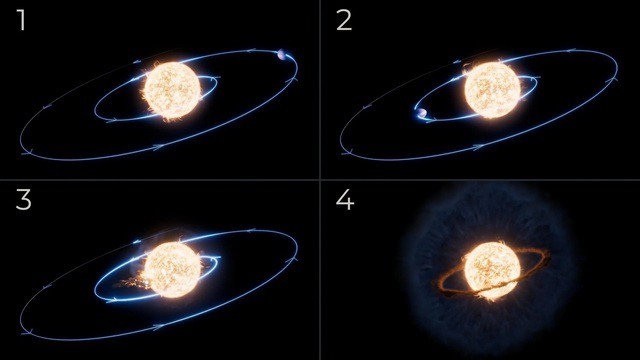A planet was just swallowed before the eyes of Earthlings
The James Webb Space Telescope, developed and operated by NASA, has just achieved a new milestone when it recorded the first images of a planet being swallowed by its parent star in real time, 12,000 light years from Earth.
A research team led by Dr. Ryan Lau, from the National Science Foundation's National Optical Infrared Astronomy Research Laboratory (NSF NOIRLab - USA) analyzed images from James Webb and told a terrifying story.

Image edited and graphics added to show how the ill-fated planet 12,000 light years from Earth was swallowed - Photo: NASA/ESA/CSA
Previously, the Palomar Observatory of the California Institute of Technology (Caltech - USA) located in San Diego recorded a flash event called ZTF SLRN-2020.
Additional observations from NASA's NEOWISE mission later showed that the flare was a star, which flared in infrared a year before the optical flare was recorded, suggesting the presence of dust.
This initial survey in 2023 led researchers to believe that the star is quite similar to the Sun.
It is beginning its aging process - exploding into a red giant - before it dies.
Subsequent observations by the James Webb Space Telescope, the world's most powerful space telescope, have clearly shown that the flash occurred when the star engulfed an orbiting planet.
The star had yet to inflate, but the ill-fated planet was soon disrupted from orbit, spiraling around the red dwarf before being completely engulfed.
This planet is estimated to be about the same size as Jupiter in the Solar System.
This terrifying image that just happened before the eyes of Earthlings may reflect the future 5 billion years from now.
That's when our Sun is thought to have aged enough to enter the red giant phase, causing it to flare up much larger than its present size.
This process would make the Sun large enough to swallow several of its closest planets, with expected victims including Mercury, Venus and Earth.
You should read it
- Detects the hottest outer planet in the universe, with temperatures up to 4,327 ° C
- New planet appears that may have life like Earth
- New discovery of life on planet GJ 1132b, 'Super Earth' is 39 light-years away
- Hot Jupiter is being torn apart by its host star
- The star about to explode is 100,000 times brighter than the Sun, the light emitted can be observed from the Earth
- How big can the stars in the universe be?
 A 'hungry' black hole has just woken up and started swallowing surrounding matter
A 'hungry' black hole has just woken up and started swallowing surrounding matter How to identify snake holes in your garden
How to identify snake holes in your garden Interesting photo series to help you understand how the world around us works?
Interesting photo series to help you understand how the world around us works? Which nuts contain the most protein?
Which nuts contain the most protein? The best time of day to take vitamin B12
The best time of day to take vitamin B12 This is the final moment when a star 'passes away'
This is the final moment when a star 'passes away'